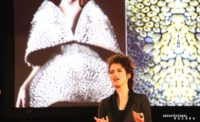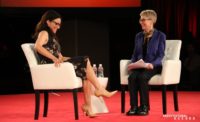After the hype generated by tight crowds, high security, and a bomb sniffing dog in anticipation of Bill Clinton’s keynote address Thursday, today’s presentations at the American Institute of Architects’ national convention in Atlanta had a decidedly more laidback, TED-like feel.
The first speaker, Welby Altidor, executive creative director for Cirque du Soleil (he also self-identifies as a “status quo Chief Challenger” on Twitter) encouraged the crowd to take a more unorthodox approach to their work. “I see in all of you the ability to trigger the element of punk rock,” he told the predominantly middle-aged, non-tattooed crowd.
The Montreal-based director, who has created shows for more than three decades, including the Michael Jackson ONE show in Las Vegas, encouraged the audience to take risks. He flashed an image of Cirque du Soleil’s first performance tent from 1984—dingy blue and white-stripe big top—that promptly collapsed after the photograph was snapped. But these early fiascoes, he said, forced the company to innovate. “Fail often,” he suggested.
Meanwhile, Julie Dixon, Research Director of National Journal's Communications Council, gave tips on creating compelling company narratives, in a speech called “Unleashing your Inner Storyteller,” underscoring advice with tear-jerker promotional videos from Google and Office Max.
As it turns out, storytelling is a major theme at this year’s convention: the AIA has embarked on a two-year public awareness campaign, launching a short documentary to promote their #ILookUp initiative at the conference.
In addition to the two keynote addresses, AIA president Elizabeth Chu Richter bestowed medals to Andrew Freear, director of Auburn University’s Rural Studio for the 2015 Whitney M. Young Jr. Award, and to architect Peter Eisenman for the Topaz Medallion for Excellence in Architectural Education.
“If you stick around long enough, they’ll give you an award,” the 83-year-old architect said. Eisenman went on to criticize the current celebrity-obsessed architecture culture, saying that young architects lack the kind of role models his generation had—the likes of Louis Kahn and Frank Lloyd Wright.
“The difference between heroes and star architects is important,” he said. “Stars are interested in power relationships. Heroes create cultural value. I hope the award you are giving me today salutes that difference.”
Watch the AIA’s new documentary here.

















Post a comment to this article
Report Abusive Comment